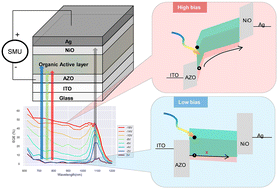Bias switchable narrowband/broadband NIR organic photodetector fabricated with a scalable technique†
Abstract
Near-infrared (NIR) and shortwave infrared (SWIR) image technologies have gained significant attention for emerging applications. However, the absorption edge of Si CMOS image sensors limits their effectiveness beyond the 1000 nm wavelength range. Solution-processed organic semiconductors, with their unique photon-to-electron responses spanning from ultraviolet (UV) to the NIR/SWIR range offer exceptional versatility in optoelectronic applications. To reduce optical noise, narrow-bandpass filters are commonly employed in front of the image sensor for NIR/SWIR applications. Therefore, the development of an image sensor capable of narrowband–broadband dual-mode switchable operation holds significant convenience. In this work, we present a bias-dependent narrowband NIR organic photodiode (OPD) fabricated by blade-coating in ambient atmosphere. The OPD, featuring a 6 μm photo-active layer (PAL), exhibits narrowband photodetection with a detectivity of 1.9 × 1011 Jones at a wavelength of 1100 nm under a bias of −2 V. However, when a bias exceeding −4 V is applied, it transitions into a broadband detector. Furthermore, the fabrication process for this dual-mode OPD is compatible with semiconductor foundry processes, demonstrating promise for large-scale production.

- This article is part of the themed collection: RSC Applied Interfaces HOT Article Collection


 Please wait while we load your content...
Please wait while we load your content...